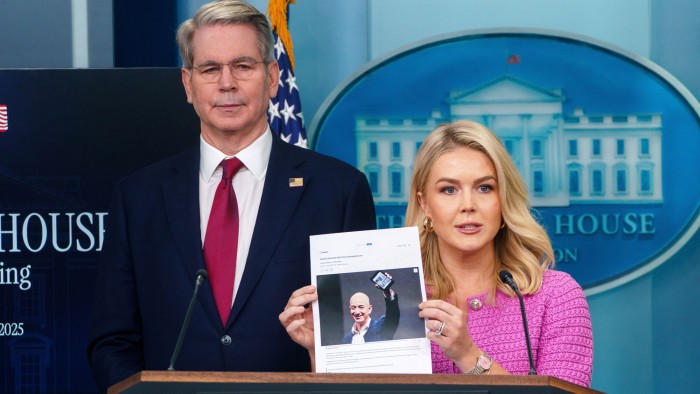Wall Street banks predict GDP contraction after US trade deficit hits record
The US trade deficit in goods surged to a record high in March as companies rushed to stockpile imports ahead of Donald Trump’s sweeping tariffs, prompting Wall Street economists to forecast that GDP shrank in the first quarter.
After the publication of official data showing a $162bn gap between imports and exports last month, Morgan Stanley, Goldman Sachs and JPMorgan predicted a contraction in output in the first three months of the year. The balance between imports and exports is an important factor in calculating GDP.
The US Census Bureau figure was the highest goods deficit on records stretching back to the early 1990s and compared with $92.8bn for March 2024.
The data reflected stockpiling by businesses in anticipation of Trump’s “liberation day” tariffs, and came out a day before Wednesday’s first-quarter GDP figures.
“The import surge ahead of tariffs was even larger than we expected, and inventories did not offset it,” economists at Morgan Stanley said. They added that as a result they slashed their first quarter GDP forecast from zero to an annualised rate of -1.4 per cent.
Goldman Sachs cut its forecast from -0.2 to -0.8 per cent, with economists at JPMorgan reducing their prediction from zero to -1.75 per cent.
The rise in the trade deficit was almost entirely down to a surge in imports — especially those with a long shelf life, such as cars, industrial materials and consumer goods.
“The picture for [the first quarter of 2025] overall remains that President Trump’s tariff threats set off a rush to buy goods now rather than face higher prices later, prompting a startling surge in imports,” said Oliver Allen, senior US economist at Pantheon Macroeconomics.
Analysts had already anticipated a slump in growth, even ahead of the Tuesday’s trade figures, with a Reuters survey predicting an annualised quarterly rate of 0.3 per cent — down from 2.4 per cent for the last three months of last year.
However, many analysts say Wednesday’s growth figures will be skewed by the extraordinary period before the tariffs took effect, when many businesses focused on stockpiling, and are likely to overstate the damage to the US economy.
“The GDP number will tell us very little,” Isabelle Mateos y Lago, chief economist at BNP Paribas, said. “It’s going to be full of noise, and reflecting to a very large extent, the sum of imports.”
She added: “You’re going to need to look really under the hood to see what’s really happening.”
“The data will be extremely noisy, both because reality is noisy and how we measure reality is noisy,” said Jason Furman, economist at Harvard University, adding he thought the data would still show “a pretty positive story” for US consumption, which has driven growth in recent years.
GDP can be calculated as the sum of the trade balance, plus consumption, investment and government spending.
Trump unveiled a series of so-called reciprocal tariffs on April 2, sparking a sharp sell-off in equities markets and an increase in the US government’s financing costs as investors priced in the risk that high levies would drive the US economy into recession and stunt global growth.
In recent weeks, concerns have mounted that high tariffs on Chinese imports will trigger goods shortages in important sectors such as construction and industrial production.
Scott Bessent, US Treasury secretary, on Tuesday rejected fears of supply chain shocks, claiming in a media briefing that American retailers had “planned accordingly”.
He said the “aperture of uncertainty” would soon be “narrowing”, with Washington closing in on a trade deal with India.
The US also had the “contours” of an agreement with South Korea and was making good progress in talks with Japan, Bessent added.
While the introduction of many “reciprocal” tariffs was paused by Trump for 90 days on April 4, a 10 per cent baseline remains in place, as does a levy of 145 per cent on most Chinese imports.
Economists say that, even without the April 2 tariffs in place, the current scenario leaves US trade levies at their highest effective rate for more than a century.
Bessent said on Tuesday the trade war was unsustainable for China and the “onus” was on Beijing to lower trade barriers.
Economists expect a partial turnaround in the second quarter as imports fall and push up GDP.
West coast ports such as Los Angeles have reported a sharp drop in cargo volumes in recent weeks, amid signs vessels carrying products from China’s east coast are turning back.
“Today’s [trade] numbers do really highlight the risk that it may well be a negative GDP print and that is obviously setting us up for a very weak 2025,” James Knightley, chief international economist at ING Bank, said.
“This is a big stockpiling effort to get ahead of tariffs . . . but we expect this to unwind pretty soon: ports data is already slowing.”
Additional reporting by George Steer in New York






